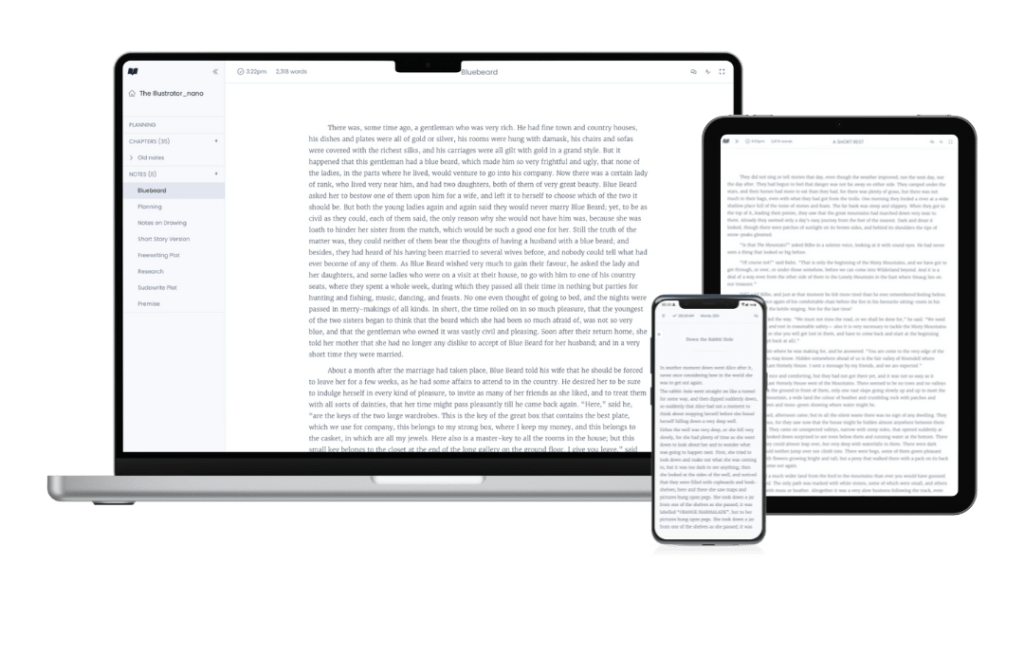
How to Write a Novel in a Year

Are you dreaming of writing a novel but don’t know where to start? Or perhaps you’ve started countless times but never made it past the first few chapters. Join our community this year as we face the challenge together and try to complete a project from start to finish!
We’ll break the process down month by month, helping you manage your time efficiently and keep the momentum going. Here’s how to turn your idea into a finished manuscript and complete your novel in a year.
January: The Foundation
A novel starts with a single idea. January is going to be all about developing your story premise, synopsis, and a plot outline.
Begin by brainstorming ideas, no matter how rough they may be, and gradually mould these into a more structured plan. It’s also a good time to settle on genre and audience, which will give you a good idea of the word count you should be aiming for (see this article for more advice on word counts).
Determine the central theme of your story. This will be the core around which all the elements of your novel will revolve. What do you want your story to be about, and what do you want it to say? Build your story premise around this theme.
Use your theme and premise to build out a plot. Whether you’re a plotter or a pantser, it’s always a good idea to have at least a vague idea of where you want your story to go, and January is the time to do just that.
February: Build Your World
With the skeleton of your plot in place, it’s time to add some flesh to the bones. Use February to build out the characters and settings that will bring your novel to life.
The backbone of any good novel is its characters. Once you have a clear idea of how your story will develop, it’s easier to assign your characters’ goals, motivations, and conflicts. You might even want to develop comprehensive profiles for your main characters, including backstories and desires.
Sketch out your settings, focusing on both the large-scale worldbuilding and the intimate spaces where key scenes will take place. Worldbuilding is often considered something that only genre writers like fantasy and sci-fi authors need to worry about, but even contemporary and literary fiction writers can learn a lot about their story direction from where and when it takes place.
March: Fast Drafting
March is all about getting some words down. To really get your creative juices flowing, we’ll be looking at a technique called fast drafting. Fast drafting is all about words on the page. Write without stopping to edit and don’t let yourself get distracted by errors or inconsistencies.
The trick to fast drafting is to make notes as you go if there’s something you want to change, and then continue the draft as if you’ve already made that change. Drafting this way means that when you come to do your first edit, you only need to make those changes once, and won’t be tempted to go over the same early chapters again and again as you discover how you want your story to develop.
To get the most out of fast drafting, set yourself a daily word count based on your ideal genre total. For instance, if I’m writing a fantasy novel of 90,000 words, I might aim for 2000+ words a day. But if I’m writing a contemporary middle-grade novel of only 45,000 words, then I would aim for 1450+ words a day.
That said, though, if you don’t want to make March a sprint, there’s no reason you can’t add a little extra time and dip into April to make it a little more manageable. You might also be happy to have a shorter word count for your fast draft, and then expand it in April to bring it more in line with genre expectations. Do whatever works for you and your schedule. The most important thing, however, is to keep the editing for later—right now, it’s all about progress, not perfection.

April: Complete Your First Draft
April is all about tightening up what you’ve written. Your fast draft from March will be rough. It will be full on inconsistencies, plot holes, and you might even have removed or added characters and settings in ways you hadn’t expected.
By reviewing your fast draft from March you can start filling in the gaps, as well as expand on what you’ve written where you need to. This is your true first draft. Think of the fast draft as you telling yourself the story, and this month is actually about making it readable. Add descriptions, flesh out scenes, and ensure the story flows coherently from one chapter to the next.
May: Refining the Details
In May, take a step back and take the time to read your entire first draft, trying to approach it like a reader would. This is the time to revise and refine the details of your novel.
After you’ve finished the first draft, you might like to expand your worldbuilding and themes, ensuring consistency and depth throughout the manuscript. This month you’ll want to take notes, with an in-depth, analytical reading of your first draft.
Does your theme carry through the entire novel? Will your reader be left with what you want them to take away from you story? Do your characters have strong and believable motivations? Do they have unique voices? Is your plot properly paced? Do all your scenes serve your story, or were there parts where you felt bored reading back over it?
An analytical mindset, and comprehensive notes as you go along will allow you to really tighten up your prose for draft two.
June: The Second Draft
With the notes you’ve collected from your close reading and proposed revisions from May, it’s time to complete your second draft. Focus on improving the structure, pacing, and overall storytelling.
Strengthen weak scenes and clarify any confusing plot points. Enhance your language and style to make your writing more engaging. Hopefully by now you’ll have developed a unique writer’s voice, and can ensure that voice is consistent through the whole draft.
July: Find Beta Readers
As daunting as it may be, July is the month we’ll be looking to share your work with actual readers! Your first draft will always be rough, so you should never share that draft with readers as you’ll rarely get useful feedback that you wouldn’t have already actioned if you’d done a close reading yourself.
When looking for beta readers for this stage, I recommend looking for a mixture of writers who can act as critique partners, as well as readers who read widely from the genre you’re writing in. Writers can help you with the more technical aspects of your writing, while readers can help shine a light on the experience of reading your book.
More than anything, I do not recommend getting family, friends, or readers outside your genre to beta read for you. You’ll almost never get useful feedback from them, as they’re either too personally invested, or won’t be your target audience. But most of all, be open to constructive criticism and note areas that consistently receive comments, even if it’s an area that you were proud of.

August: Complete Your Third Draft
Now that you have feedback from beta readers and critique partners, you can start working on your third draft. Address the comments you received and make necessary changes to enhance your story.
Continue to refine your narrative, polishing every aspect of your novel. We’re quickly approaching the finish line!
September: Final Feedback
With your third draft completed, it’s time to get some final feedback from beta readers. Unlike your previous round of beta readers, this time you want to target readers only.
My personal recommendation is to have a mix of your previous beta readers as well as new ones. You’ll get valuable insight from those who can compare your new draft with the one they read before. But you’ll get completely different insight from readers who are coming to your work with fresh eyes.
This time, you can give your readers some guidance. Ask them to focus on the finer details, which will let you ensure everything aligns with your vision. If there’s anything about your plot or your writing style you’re not sure about, don’t be afraid to ask. Your pool of beta readers is not an infinite resource, so you want to make sure you’re getting the most out of them while they’re available to you.
October: The Final Draft
With your second round of beta reading out of the way, and hopefully some helpful feedback, you can now begin the process of self-editing your final draft. This is where you fix any remaining issues and work on the nitty-gritty details of sentence structure, dialogue, and grammar.
At this point, you want to ensure that your manuscript is as clean and professional as possible as you start to prepare it for publication.
November: The Finishing Touches
With your final draft completed, now is the time to really make sure you’re ready for the next steps. Conduct a final proofread to catch any last-minute mistakes, or especially if you’re planning to self publish, you might want to consider hiring a professional editor to give you manuscript a once over.
November is also the time to finalise your publishing plans. Do you want to pursue the traditional route, self-publishing, or release your work for free on a website, blog, or fan site?
Now is the perfect time to research which avenue is best for you. If you’re trad publishing you’ll need to research and vet agents and publishers, or, if self-publishing, you’ll need to format your manuscript according to platform guidelines, and make sure you commission some good quality cover art.
December: Put Your Work Out There
The final step in your year-long journey is to get your novel out into the world. Send out those query letters or begin the self-publication process.
But most of all, celebrate your hard work and dedication—writing a novel in a year is a major accomplishment!
The best news is, that you don’t have to do this alone. Join the Novlr Community as we take on the challenge (I’ll be writing alongside you) with critique groups, accountability buddies, and some dedicated cheerleaders to keep you motivated along the way.
This is your year. Let’s all work together and bring our stories to the world!
































